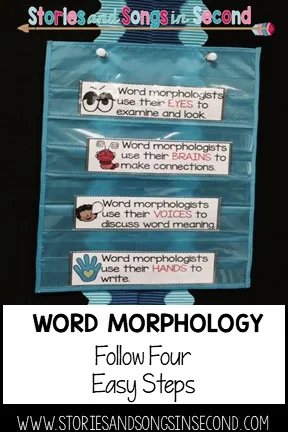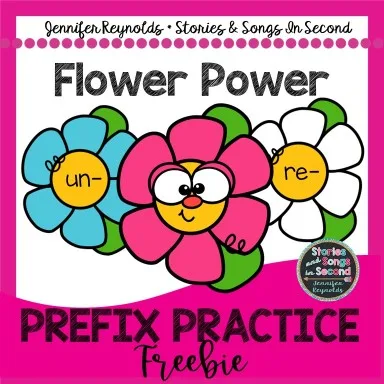5 Word Morphology Activities for
Primary Grade Students
Incorporating word morphology lessons into your literacy instruction is guaranteed to increase student engagement, build their vocabulary, boost understanding of word meaning, and improve decoding skills! The materials and lessons featured in this post were developed for one of my annual observation lessons with my second graders, and have stood the test of time and tweaking over the years! I promise you that they are kid-tested and teacher approved!
What Is Word Morphology?
I created this presentation to help explain what word morphology is and get my students excited about studying the structure of words and how adding prefixes and suffixes to base words can change their meaning. It was a helpful introductory activity as my class discussed how prefixes and suffixes transform how words are read and what they mean. Be sure to complete the opt-in form at the end of this post to get this FREE set of Google Slides! It can be printed and posted on a bulletin board or projected on your Smartboard!
What Are The Steps To Being A Word Morphologist?
After introducing the concept of word morphology to my readers, we review the four important steps they need to follow when analyzing a word, breaking into parts, deciphering the meaning, and then using it in their writing.
You can download these FOUR STEP pocket chart cards for free {HERE} They will provide your students visual steps to follow as they work to add and/or take away common prefixes and suffixes from base words.
- Word morphologists use their eyes to examine and look.
- Word morphologists use their brains to make connections.
- Word morphologists use their voices to discuss word meaning.
- Word morphologists use their hands to write.
What Materials Can We Use to Practice Word Morphology?
When I originally planned my morphology observation lesson, I created laminated puzzle pieces for my student partners to write prefixes, base words, and suffixes on. The idea was for the pairs to swap their word puzzles with another team to read, put together, and write. Let me just say this.....
IT DID NOT GO WELL!
Thank goodness that my years of teaching experience had taught me to think quickly on my feet! We stopped, cleaned up the activity, and took a movement break. We also took three deep calming breathes and gathered at the carpet. On my way there, I pulled some different size Lego blocks out of our recess cupboard, tore off a new piece of chart paper, grabbed some Sharpies and shifted to Plan B!
I had two student assistants join me at my easel and hold up a small Lego block for a prefix or a suffix, and a large Lego block for the base word. After I had charted some examples for re-, -un, and -ful for the group, I sent them back to their partner teams, with Legos, highlighters, and notebook paper to build their own new words using the following formulas:
PREFIX + BASE WORD
BASE WORD + SUFFIX
If you do not have a large supply of Legos on hand, students could use two colors of letter magnets, or short and long sentence strip pieces. Many of them started calling their word creations Lego Word Trains! The prefix was the engine in front of the train pulling the base word and giving it new meaning! The suffix was the caboose coming after the base word and giving it new meaning!
What Resources Will Help Students Practice Word Morphology?
When your students are ready for pencil and paper practice word morphology, my
FREE PREFIX FLOWER POWER resource provides them with the opportunity to create their own
un- and re- garden of flowers and show their prefix power! A pre-test and post-test is provided, along with sentence writing practice sheets to help your group show that they know what the words mean!
How Can Reading Adapted Nursery Rhymes Help Students?
What if the mouse in Hickory Dickory Dock tried to unlock the clock?
What if Mary had an unhappy little lamb?
What if the Itsy Bitsy Spider tried to reclimb the spout again?
All these questions about familiar Mother Goose verses and more are answered in my PREFIX PALS
poetry pack! I have used this resource successfully with both second and third graders to build not only understanding of vocabulary and word meaning, but also to practice decoding and boost fluency skills!
The following materials are included and can be used for whole group lessons, partner work, or as independent literacy stations:
- Prefix example card for un-
- Mary Had a Little Lamb and Hickory Dickory Dock adapted poems and practice worksheets
- Prefix example card for re-
- Humpty Dumpty, Jack and Jill, and Itsy Bitsy Spider adapted poems and practice worksheets
- Seven pre- and post-assessment worksheets
For now, do not forget to grab the HOW TO BE A DOCTOR Google Slide presentation below to help you launch your own classroom unit on word morphology! And if you are looking for more literacy ideas related to reading fluency, check out this blog post:
As always, thanks for being here! I hope you always find creative ideas and resources to help you work smarter, not harder! If you have some great ways that you teach word morphology, I would love for you to share them in the comments!
Keep a song in your heart and a book in your hand!
PIN FOR LATER




























